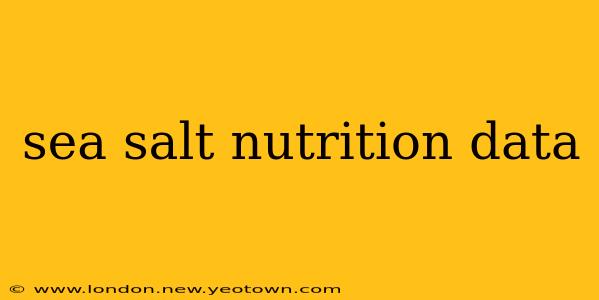Sea salt. The very words conjure images of sun-drenched beaches, crashing waves, and a delicate, nuanced flavor that elevates any dish. But beyond its culinary appeal lies a rich nutritional profile often overlooked. This isn't your average table salt; sea salt boasts a unique composition of minerals that go beyond simple sodium chloride. Let's embark on a journey to uncover the secrets within those tiny, glistening crystals.
What is Sea Salt? A Quick Overview
Before delving into the nutritional details, it's crucial to understand what exactly constitutes sea salt. Unlike refined table salt, which undergoes extensive processing, removing most minerals, sea salt is harvested directly from evaporated seawater. This natural process preserves many of the minerals naturally present in the ocean, giving it its distinctive flavor and nutritional complexity. The exact mineral content can vary widely depending on the location of the harvest, the specific method of production, and even the weather conditions.
Sea Salt vs. Table Salt: A Nutritional Comparison
This is where the real intrigue begins. While both provide sodium, the similarities largely end there. Table salt, primarily sodium chloride, is often fortified with iodine to prevent iodine deficiency. Sea salt, however, offers a broader spectrum of minerals, including:
- Potassium: Essential for maintaining fluid balance and nerve function.
- Magnesium: Crucial for muscle and nerve function, blood sugar control, and blood pressure regulation.
- Calcium: Vital for bone health, muscle contraction, and nerve transmission.
- Zinc: Supports the immune system and wound healing.
- Iron: Essential for red blood cell production and oxygen transport.
The amounts of these minerals vary depending on the source and type of sea salt, but it's this diverse mineral profile that sets sea salt apart.
How Much Sodium is in Sea Salt?
This is a frequently asked question, and the answer isn't straightforward. The sodium content of sea salt can vary, typically ranging from 38% to 40% sodium by weight. This means that while sea salt offers additional minerals, it still contains a significant amount of sodium. Therefore, moderation is key, particularly for individuals watching their sodium intake due to health concerns like high blood pressure.
Is Sea Salt Lower in Sodium than Table Salt?
Not necessarily. While the total mineral content differs, the sodium content is roughly comparable between sea salt and table salt. The difference lies in the type of salt and additional minerals present, not necessarily the overall sodium content.
Does Sea Salt Have Fewer Calories Than Table Salt?
Both sea salt and table salt are virtually calorie-free. The caloric difference is negligible.
What are the Benefits of Sea Salt?
The benefits of sea salt largely stem from its additional minerals. These trace minerals offer potential benefits but further research is often needed to confirm these claims definitively. It's important to remember that while sea salt offers these minerals, it's unlikely to be a significant source of them in your overall diet. A balanced diet rich in fruits, vegetables, and whole grains remains the best approach for optimal mineral intake.
Are there any Downsides to Sea Salt?
The primary downside of sea salt remains its sodium content. Excessive sodium intake can contribute to high blood pressure, increasing the risk of heart disease and stroke. Therefore, mindful consumption is paramount, regardless of the type of salt used.
Conclusion: A Flavorful Balance
Sea salt offers a more complex and flavorful culinary experience compared to refined table salt. Its diverse mineral profile adds a layer of nutritional intrigue, but it's important to remember that the sodium content remains a significant factor. Incorporate sea salt judiciously into your diet, appreciating its unique qualities while remaining mindful of overall sodium intake. A balanced approach, combined with a healthy lifestyle, will allow you to savor the flavor and potential benefits of this natural culinary treasure.

